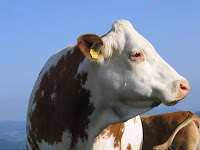
Starting out in this business many years ago by writing for a purebred cattle magazine, I discovered early on how many cattle operations are based on outside money or inherited capital. Lots of the leading breeders were from other industries. I wrote stories about engineers, airplane pilots, and doctors who were raising cattle as a sideline, tax writeoff, or hobby. Prosperous farmers had purebred cattle, too.
So, now when I hear the questions from young and beginning farmers and ranchers about how to get more land, and get started in cattle, you think, well, maybe you just as well ask how do you get rich. Or what is the meaning of life?
Two discussion threads in Agriculture Online this week explore the knotty questions of how you rent more land and how you make money in cattle.
On the land question, well, the tips include:
* Marry a woman who owns 1,500 acres.
* Put an ad in the paper.
There is also this bit of advice:
"Other than offering more money for cash rent, there are some in our areas trying a base cash rent with a share in any excess bushels for the landlord when the yield per acre is above a set trigger number. Some of the local landowners in our area are renting for your choice of $375/A paid up front or 75 bushels of dry corn delivered to the elevator of the landlord's choice."
Add your two cents in Farm Business Talk
On the cattle question, "Is there money in cattle," a would-be cattleman is given a good range of advice:
* Base the operation of direct marketing to consumer.
* Take it slow while you learn the cattle business and figure out where your energy level is. The energy you have determines a lot about the size and type of your operation unless you're rich and can hire everything done.
* Watch your costs closely and feed byproducts when possible to cut those costs.
* Find someone who will let you work with them to learn cattle. You should find out real fast it that is the animal for you. Then if you're still interested, look into using rotational grazing for your operation.
* Start small. But be big enough to get your feet wet. Just don't be so big that if you screw up it will break you.
* Don't skimp on the quality of the cattle. Work with a reputable dealer or go to an auction where you can buy a straight load or half a load of good quality cattle from one owner. This will save you a lot of the headaches of health problems.
* Buy yearling cattle, not fresh weaned calves, again because of the health.
* Small operations need to lock in profitability via futures or option hedges. Otherwise, you are just playing chicken with the market, given the wide swings in prices from week to week.
Have anything to add? Join the discussion: Is there money in cattle?
